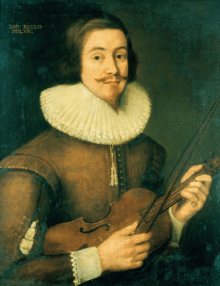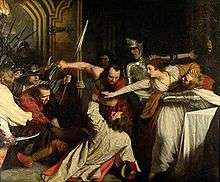David Rizzio
David Rizzio (/ˈrɪtsioʊ/, Italian: [ˈrittsjo]; c. 1533 – 9 March 1566),[3] sometimes written as David Riccio (/ˈrɪtʃioʊ/, Italian: [ˈrittʃo]) or David Rizzo, was an Italian courtier, born close to Turin, a descendant of an ancient and noble family still living in Piedmont, the Riccio Counts di San Paolo e Solbrito, who rose to become the private secretary of Mary, Queen of Scots. Mary's husband, Lord Darnley, is said to have been jealous of their friendship, because of rumours that he had impregnated Mary, and joined in a conspiracy of Protestant nobles, led by Patrick Ruthven, 3rd Lord Ruthven, to murder him. The murder was the catalyst for the downfall of Darnley, and it had serious consequences for Mary's subsequent reign. Mary was having dinner with Rizzio and a few ladies-in-waiting when Darnley joined them, accused his wife of adultery and then had a group of knaves murder Rizzio[4], who was hiding behind Mary. Mary was held at gunpoint and Rizzio was stabbed numerous times. His body took 57 dagger wounds.[5]

Career
Rizzio (whose name appears in Italian records as David Riccio di Pancalieri in Piemonte) went first from Turin to the Court of the Duke of Savoy, then at Nice. However, finding no opportunities for advancement there, he found means to get himself admitted into the train of the Count de Moretto in 1561, who was about to lead an embassy to Scotland.[6] The Court in Scotland had no employment for Rizzio, and dismissed him. He ingratiated himself with the Queen's musicians, whom she had brought with her from France. James Melville, a friend of Rizzio, said that "Her Majesty had three valets in her chamber, who sung three parts, and wanted a bass to sing the fourth part".[7] His salary for the post of valet was 150 Francs or £75 Scots.[8]
Rizzio was considered a good musician and excellent singer, which brought him to the attention of the cosmopolitan young queen. Towards the end of 1564, having grown wealthy under her patronage, he became the queen's secretary for relations with France, after the previous occupant of the post had retired. Rizzio was ambitious, controlling access to the queen and seeing himself almost a Secretary of State. As a Catholic and a foreigner other courtiers felt he was too close to the queen. Rumours became rife that Mary was having an adulterous affair with Rizzio.
Murder

Jealousy precipitated his murder in the Queen's presence, in her supper chamber in the Palace of Holyroodhouse on Saturday 9 March 1566 at 8 o'clock. The royal guards were overpowered and the palace was turned over to the control of the rebels. Mary and Rizzio were in a supper room, which still exists as part of the bedchamber, and was then "a cabinet about XII foot square, in the same a little low reposinge bedde, and a table" according to an account of the murder written by Francis, Earl of Bedford and Thomas Randolph.[9]
The Queen was six months pregnant (with James VI) at the time, and Rizzio was accused of having impregnated her. Having burst into the Queen's private supper room, the rebels, led by Lord Ruthven, demanded Rizzio be handed over. The Queen refused. Rizzio then hid behind Mary but was nevertheless seized and stabbed to death in the presence of the Queen. According to Mary, one of the intruders, Patrick Bellenden brother of the Lord Justice Clerk, pointed his gun at her pregnant belly, while Andrew Kerr of Faldonsyde threatened to stab her. Lord Ruthven denied this.[10]
After this violent struggle, Rizzio was dragged into the adjacent Audience Chamber and stabbed an alleged 57 times. His body was thrown down the main staircase nearby (now disused) and stripped of his jewels and fine clothes.[11] The location of Rizzio's murder is marked with a small plaque in the Audience Chamber, underneath which is a red mark on the floorboards which reportedly was left when Rizzio was stabbed to death.
Rizzio was first buried in the cemetery of Holyrood Abbey.[12] Buchanan states that shortly afterwards his body was removed by the Queen's orders and deposited in the tomb of the kings of Scotland in Holyrood Abbey.[13] This strengthened the previous rumours of her familiarity with him.[14] Rumours were thrown around about the motive for the murder – some claimed Darnley was jealous, or that powerful lords sought to manipulate Darnley and remove an irritating presence at court.
Aftermath
Immediately after the murder Mary was able to speak to Lord Darnley, and may have convinced him they were both in danger and captives in the palace. The guard around her was relaxed and at midnight the next day they escaped and she rode behind Arthur Erskine to Seton Palace and then to safety at Dunbar Castle. An English servant of Lord Darnley Anthony Standen later claimed to have accompanied the queen with John Stewart of Traquair and his brother William Stewart.[15] Mary returned to Edinburgh with her supporters, and took up lodgings on the Royal Mile rather than return to the palace. On 21 March she had Darnley declared innocent of the murder.[16]
Robert Melville arrived in Edinburgh from London and reported back to Elizabeth and Cecil on the aftermath of the murder. He noted that Morton, Lord Ruthven, Lord Lindsay, William Maitland of Lethington, the Clerk Register James Balfour, the Lord Justice Clerk John Bellenden (whose brother was alleged to have pointed a gun at the queen), and some gentlemen of Lothian, who were all suspected of having knowledge of the plan had fled.[17]
Rizzio's brother, Joseph, arrived in Scotland with Michel de Castelnau and was appointed secretary in David's place by 25 April 1566. Joseph and an Italian colleague, Joseph Lutyni, had some trouble over coins taken from the queen's purse, and in April 1567 he was accused and acquitted with Bothwell of Darnley's murder.[18]
Legacy and memorial
David Rizzio's career was remembered and referred to by Henry IV of France. Mocking the pretension of James VI of Scotland to be the "Scottish Solomon", he remarked that "he hoped he was not David the fiddler's son", alluding to the possibility that Rizzio, not Darnley, fathered King James.
It has been alleged that Rizzio is buried at Canongate Kirkyard, Edinburgh; this would have required reinterment of a Catholic with no living friends in a Protestant graveyard 120 years after his death. It is considered more likely that he lies in an unmarked grave in the graveyard attaching Holyrood Abbey. The Protestant historian George Buchanan wrote in 1581 that David was first buried outside the door of the Abbey, and then Mary arranged for him to be buried in the tomb of her father James V and Madeleine of France within. As Buchanan described this circumstance as reflecting badly on the Queen, while his book was at the printers, a friend James Melville tried to get Buchanan to rewrite the passage, fearing that Mary's son James VI would suppress the whole book. Buchanan asked his cousin, Thomas Buchanan, a schoolmaster in Stirling, if he thought the story was true, and the cousin agreed. The story was published.[19]
Representation in visual media and fiction
Rizzio was played by John Carradine in the 1936 RKO picture Mary of Scotland; by Ian Holm in the 1971 movie Mary, Queen of Scots; by Tadeusz Pasternak in the BBC mini-series Gunpowder, Treason, and Plot; by Andrew Shaver in The CW network television show Reign; and by Ismael Cruz Córdova in the 2018 film Mary Queen of Scots.
The murder of Rizzio and the subsequent downfall of Darnley form the main subject of the 1830 play Maria Stuart by Juliusz Słowacki.
Rizzio's life and death are a key plot element in Caleb Carr's Sherlock Holmes story The Italian Secretary, Holmes vocally dismissing the idea that Rizzio was ever anything more than entertainment.
Arthur Conan Doyle used the death of Rizzio as a plot point in his 1908 story, “The Silver Mirror”.
The takers in hand
Thomas Randolph listed these men as participants in Rizzio's murder:[20]
- Earl of Morton
- Patrick Ruthven, 3rd Lord Ruthven
- Patrick Lindsay, 6th Lord Lindsay
- William Maitland of Lethington
- Master of Ruthven
- John Cockburn, laird of Ormiston
- William Sinclair of Herdmanston, laird of "Haughton"
- John Crichton, laird of Brunstane
- The laird of Whittinghame
- The laird of Lochleven
- The laird of Elphingstone (Johnston)
- Patrick Murray
- Andrew Kerr of Fawdonsyde, son-in-law of John Knox
- William Tweedie of Drumelzier
- Adam Tweedie of Dreva
with the preachers; John Knox and John Craig.
References
- Portrait of a man known as David Rizzio, Royal Collection
- Fraser, Antonia (1994) [1969]. Mary Queen of Scots. London: Weidenfeld and Nicolson. p. 236. ISBN 0-297-17773-7.
- Henderson, Thomas Finlayson (1896). . In Lee, Sidney (ed.). Dictionary of National Biography. 48. London: Smith, Elder & Co. pp. 98–100.
- Mary, Queen of Scots, by Antonia Fraser, 1969
- Overview of David Rizzio
- Labanoff, A., Lettres de Marie Stuart, vol. 7 (Dolman, London, 1862), p. 65, Letter to Cosmo Ier, Duke of Tuscany 1566.
- Hawkins (1778).
- Gordon Donaldson, Thirds of Benefices (Edinburgh, 1949), p. 155.
- HMC Calendar of the manuscripts of the Most Honourable the Marquess of Salisbury preserved at Hatfield House, Hertfordshire, vol. 1 (London, 1883), p. 333, and in Thomas Wright, Queen Elizabeth and her Times, vol. 1 (London, 1838), pp. 226-235.
- Thomas Wright, Queen Elizabeth and her Times, vol. 1 (London, 1838), pp. 229-30.
- Daniel, William S. (1852), History of The Abbey and Palace of Holyrood. Pub. Edinburgh: Duncan Anderson. p. 75.
- Joseph Stevenson, The History of Mary Stewart: From the Murder of Riccio Until Her Flight Into England by Claude Nau (Edinburgh, 1883), p. 16, 227.
- Daniel, William S. (1852), History of The Abbey and Palace of Holyrood. Pub. Edinburgh: Duncan Anderson. p. 76.
- Ruthen (1815).
- Joseph Stevenson, The History of Mary Stewart: From the Murder of Riccio Until Her Flight Into England by Claude Nau (Edinburgh, 1883), pp. ciii, 11, 16, 227.
- Thomas Wright, Queen Elizabeth and her Times, vol. 1 (London, 1838), pp. 230-1.
- Calendar State Papers Scotland, vol. 2 (Edinburgh, 1900), 267, 272, 274-5.
- Calendar State Papers Scotland, vol. 2 (Edinburgh, 1900), 276, 311, 320.
- Buchanan, George, History of Scotland, book 17 chapter 65: Aikman James, translation, vol.2 (1827), p.483 & footnote: The Diary of Mr James Melville, Bannatyne Club (1829) p.86: Holyroodhouse is within the old Canongate jurisdiction, which pre-dated the Canongate Kirk and burying ground, thus Riccio's death is recorded in the Canongate registers.
- Calendar of State Papers Scotland, vol. ii (1900), 269–270.
- Ruthen, Lord (1815). Some Particulars of the Life of David Riccio, chief favourite of Mary Queen of Scots. London: Triphook.CS1 maint: ref=harv (link)
- The Register of the Privy Council of Scotland, edited by John Hill Burton, LL.D., vol.1. 1545–1569, Edinburgh, 1877, p. 437, lists all those charged with "the slauchter of David Riccio." Given the very many names shown, it presumably includes those in the wider conspiracy.
- Hawkins, Sir John (1778). History and Character of Scots Music, including Anecdotes of the Celebrated David Rizzio. Universal Magazine, October 1778.CS1 maint: ref=harv (link)
External links

- Manuscript of extracts of letters sent by Mary to her uncle, the Cardinal of Lorraine, with news of the murder from the Bibliothèque nationale de France